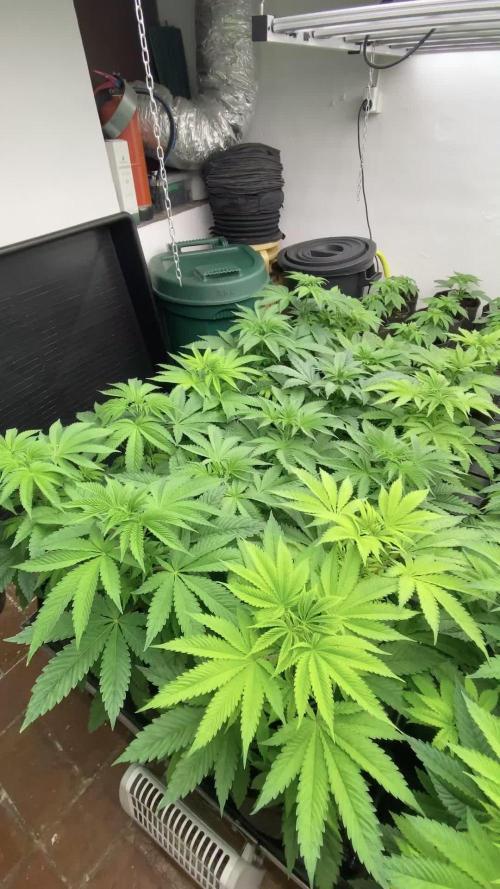The Grow Awards 2026 🏆 



























Likes
Comments
Share


@CocoLogic
Follow
Sept 13th: (F27)
Fertigation once a day with same recipe (1200 EC 6.1 PH) watered until 10-20% run-off
Sept 14th: (F28)
Fertigation once a day with same recipe (1200 EC 6.1 PH) watered until 10-20% run-off
Sept 15th: (F29)
Fertigation once a day with same recipe (1200 EC 6.1 PH) watered until 10-20% run-off
Sept 16th: (F30)
Fertigation once a day with same recipe (1200 EC 6.1 PH) watered until 10-20% run-off
Sept 17th: (F31)
Fertigation once a day with same recipe (1200 EC 6.1 PH) watered until 10-20% run-off
Had to supercrop 1 branch on the PE#2 since it was almost in the roof of the tent
Sept 18th: (F32)
Fertigation once a day with same recipe (1200 EC 6.1 PH) watered until 10-20% run-off
Sept 19th: (F33)
Fertigation once a day with same recipe (1200 EC 6.1 PH) watered until 10-20% run-off
Likes
88
Share


@Kitties_and_Colas
Follow
~_~_~_~_~_~_~_~_~_~_~_~_~_~_~_~_~_~_~_~_~_~_~_~_~_~_~_~_~_~_~_~_~_~_~_~_~_~_~_~_~_~_~_~_~_~_~_~_~_~_~_~_~_~_~_~_~_~_~_~_~_~_~_~_~_~_~_~_~_~_~_~_~_~_~_~_~_~_~_~_~_~_
❤️💡🌱😽💨
It been a great week..Bud sites are prominent now and I love the node spacing, these should be some top heavy girls very soon lol.. we noticed some yellowing on some of the taller plants, we attributed this to our earlier PH drama but its likely light stress so we moved the fixture up a few more inches (no light meter 😞 ... ).. They're beginning to smell like citrus/ lemon but its mild atm.. not too much else to report but we'll update if anything changes, thanks as always for dropping by and happy harvests everyone!! ❤️🌱~_~_~_~_~_~_~_~_~_~_~_~_~_~_~_~_~_~_~_~_~_~_~_~_~_~_~_~_~_~_~_~_~_~_~_~_~_~_~_~_~_~_~_~_~_~_~_~_~_~_~_~_~_~_~_~_~_~_~_~_~_~_~_~_~_~_~_~_~_~_~_~_~_~_~_~_~_~_~_~_~_~_
01/31
We're still yellowing some but mostly on the larger plant..I'm not entirely sure what's going on.. I lifted the light a little more and raised PH to 6.8 for last watering, we'll see what happens
😺👍
~_~_~_~_~_~_~_~_~_~_~_~_~_~_~_~_~_~_~_~_~_~_~_~_~_~_~_~_~_~_~_~_~_~_~_~_~_~_~_~_~_~_~_~_~_~_~_~_~_~_~_~_~_~_~_~_~_~_~_~_~_~_~_~_~_~_~_~_~_~_~_~_~_~_~_~_~_~_~_~_~
Likes
12
Share


@BeHappyNtoke
Follow
Week four after flipping to 12/12 still no signs of anything maybe it’s liking the cycle as a way of managing roots in the small pot still not using a crazy amount of nutes only Time will tell
Likes
1
Share


@ChameleonsCannabis
Follow
Hung for 8 days. 75f 50-65%rh. The smell off the blueberry literally smells like if somebody blew a blueberry flavored vape in my face. I dry trimmed it and it was smelling ripe let me just say. Put it in jars and had to get rh down was floating up to about 70 but every time I opened that jar the smell got better and better. Round nugs like golf balls I smashed mine while they were wet still a little bit out of excitement and checking for dry but this bud is awesome and was strong enough to survive me so.. hope thst says enough
Likes
62
Share


@OwlGang_Uk
Follow
Week 7 - Oh Mehn There’s So Much To Say About These Girls, I’ll Start With The Purple Power, It Is Ready To Be Harvest Anyday Now But I’m Looking To Push It To Week 8, It Has A Strong Aroma Of Sweet Berries. The Stardawg And Girls Scout Cookies (3gal) Are Putting On Some Dense Nuggets I Like How They’re All Looking Identical That’s A Good Sign. The Stardawg Has A Lemon But Earthy Scent And The 3gal Girls Scout Cookies Smells Like A Citrus Lemon With A Hint Of Pine, The Buds Are So Hard And Sticky Mehn I Cant’t Wait To Taste These Girls. The Other Don’t Have A Scent And The Gorilla Glue Having Start To Flower Yet Probably Gonna Steal The Show In The End! And I Would Like For MSNL To Acknowledge I Grew There Auto Lemon OG Up To A 100cm
Be Sure To Like My Grow Diary.
Height Chart:
Girls Scout Cookies: 30 1/2 (3gal)
Purple Power: 29 1/2 inches
Stardawg: 34 1/2
Girls Scout Cookies: 37 1/4 inches
Gorilla Glue: 24 inches
Lemon OG: 39 1/4 Inches
Likes
14
Share


@Endzo
Follow
Girls officaly went into pre-flower and all are confirmed female. The Orion F1 is the strongest of the bunch. All three have grown almost double the size of the other 2 strains. Epsilon is 2nd strongest growing robust and strong and the Apollo F1 have been anything but tall. Apollo F1 is a stubby bush with almost no space between nodes. I will have to defoilate here pretty heavy over the next week or so and hope the stretch comes on strong with them. Making sure to feed them supplemental nitrogen this grow after noticing a hole in N from my past feedings. Everything is on the up and up and moving along great.
Likes
43
Share


@Master_weeda
Follow
Bonjour à tous les padawans et maîtres jedis
Jour106 arrosage avec 2 litres d'eau ph6.3.
Jour108 arrosage avec 2 litres d'eau ph6.3
Processing
Likes
6
Share


@Peteg420
Follow
Week 2 and three i was really busy and didn't get good picks.. But I have 3 thorsberry regs.. I can't wait til I can see if they are male or female lol. Im slowly working toward getting my grow all set up.. Thx for any advice$!
Likes
14
Share


@iLoveGoodWeed
Follow
She is almost ready the buds are getting dens and covered in crystals
Processing
Likes
2
Share


@Justrite
Follow
Added temp and fan controllers to keep the new ones happy as they were being neglected a bit .
Likes
6
Share


@Noname121r
Follow
Coming to end of week 3 day 25 flowering. All looking pretty good. Couple that are more advanced than others but sure the others will get there.
Humidity a bit high. Do have a big ass freestanding a/c dehumidifier just need to concuct a way of making it usable.
Likes
5
Share


@KannaGrowing
Follow
Ha llegado el momento de pasar a la fase floración.
Ajustamos nuestras luminarias LazerLite Pro 720w a 12 horas y subimos la potencia al 50%.
Seguimos con riegos alternos de fertilizante y agua.
Likes
49
Share


@LockDownGrow
Follow
So this plant is doing very well and fattening up nicely , she has had her last dose of pk now ,
Fast buds do not give anything away with there tester seeds , but I am wondering from the flower formation of this could be the gelato auto they are going too bring out this year ?
Likes
16
Share


@Esjey
Follow
Hello, this week and the next ones will be peaceful. It's +-34 days of the girls' life. About 30 more days and we'll switch to flowering. The smell is delicious. I hope that the girls will also give me lush buds. Due to the use of new plant cultivation techniques, I have small concerns about growth, but I hope that my technique will work and I will base on it. (34 days of feminized seeds and the stem at the base has a circumference of 4.5 cm 😁. I should also start fertilization now, but it's already over. If I waited, I would have a problem with bending the stems.
Best regards for all
Smoke weed every day ✌️
































